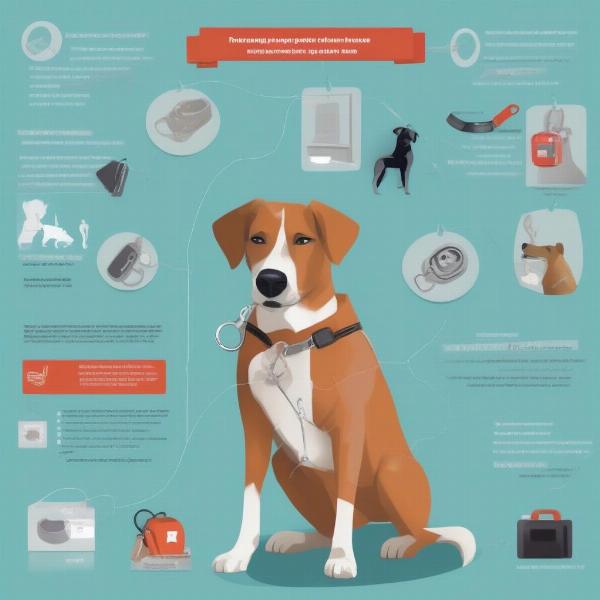Dog theft is a devastating reality for many pet owners. The thought of losing a beloved companion is heartbreaking, and it’s crucial to take proactive steps to protect your furry friend. This comprehensive guide will delve into the various aspects of dog theft, from understanding the motivations behind it to implementing effective preventative measures and knowing what to do if the worst happens.
 Dog theft prevention measures
Dog theft prevention measures
Why Does Dog Theft Happen?
Several factors contribute to the occurrence of dog theft. Financial gain is a primary motivator, as certain breeds can be sold for significant sums. Sadly, some stolen dogs are used for dog fighting or other illegal activities. Occasionally, dogs are stolen by individuals who believe they are “rescuing” the animal from perceived neglect, even if the dog is well-cared for.
Practical Steps to Prevent Dog Theft
Protecting your dog requires a multi-pronged approach. Here’s a breakdown of essential preventative measures:
- Microchipping: This is arguably the most crucial step. A microchip is a small, permanent identification device implanted under your dog’s skin. Ensure your contact information associated with the microchip is up-to-date.
- Secure Leash and Harness: Use a sturdy leash and harness, especially in public areas. Avoid retractable leashes, as they can easily be broken or snatched.
- Identification Tags: Your dog should always wear a collar with ID tags containing your current contact information.
- Home Security: Ensure your yard is secure with high fences and locked gates. Consider installing security cameras to monitor your property.
- Supervision: Never leave your dog unattended in public places, including tied up outside stores or in your car. Even a short absence can create an opportunity for theft.
- Social Media Caution: Avoid posting details about your dog’s breed, daily routines, or your whereabouts on social media. This information can be used by thieves to target your pet.
- Be Wary of Strangers: Teach your dog to be cautious of strangers and not to accept food or treats from unknown individuals.
What to Do If Your Dog Is Stolen
If the unthinkable happens, act swiftly:
- Report to the Police: File a police report immediately. Provide as much detail as possible, including photos, descriptions, and any identifying marks.
- Contact Animal Shelters and Rescuers: Notify local animal shelters, rescue organizations, and veterinary clinics about your missing dog.
- Spread the Word: Utilize social media platforms, online forums, and community groups to share information about your stolen dog. Include clear photos and descriptions.
- Check Online Marketplaces: Monitor online classifieds and marketplaces for any signs of your dog being sold.
How can an anti-theft dog collar help?
While no method is foolproof, an anti-theft dog collar can add another layer of security. Explore options like GPS trackers and collars with built-in alarms. You can find more information about these on our anti theft dog collar page. Consider personalizing your dog’s belongings, like their food bowl, which you can explore further on our personalised dog bowls australia page.
Staying Vigilant is Key
Dog theft is a serious issue that requires constant vigilance. By implementing these preventative measures and knowing how to react if your dog is stolen, you can significantly reduce the risk and be prepared to act quickly if needed. Remember, your dog’s safety is paramount.
FAQ
- What are the most commonly stolen dog breeds? Popular and expensive breeds are often targeted, such as French Bulldogs, Bulldogs, and Poodles.
- Should I put my address on my dog’s ID tag? While including your phone number is essential, consider only putting your city and state on the tag to avoid giving away your exact location.
- Are GPS trackers for dogs reliable? GPS trackers can be a valuable tool, but their effectiveness depends on factors like battery life and network coverage.
- What should I do if I see someone acting suspiciously around my dog? Remove your dog from the situation immediately and report any suspicious activity to the authorities.
- Can I recover my dog if it’s stolen? While it’s not guaranteed, many stolen dogs are reunited with their owners thanks to proactive measures and community involvement. You may also find carrying your dog in a dog crossbody bag helps keep them close and safe.
Conclusion
Protecting your dog from theft requires proactive measures and awareness. From microchipping and secure leashes to home security and social media caution, every step contributes to your dog’s safety. By staying informed and vigilant, you can significantly reduce the risk of this devastating experience. Don’t forget to secure their environment at home too, perhaps with an automatic dog food dispenser or a dog cage lock. Remember, your furry friend relies on you for their well-being.
ILM Dog is a leading international pet website dedicated to providing expert advice and resources on all aspects of dog care and wellbeing. From breed selection and health to training, nutrition, and grooming, we offer practical and reliable information for dog owners worldwide. We help you navigate the world of dog ownership with confidence. Contact us at [email protected] or +44 20-3965-8624. Visit ILM Dog for more information.